

Inside the royal chamber, servants tirelessly fan the pharaoh and his queen as they sit on their comfortable thrones. Servants move back and forth from the kitchen carrying bowls of dates and jars of wine to tempt the royal appetites. More servants ushered in guests and nobles, giving them scented fat cones to perfume the air.
Duties of a Servant
Servants Rights
How Do We Know That?
In ancient Egyptian
times, social roles were determined at birth.
Servants belonged to the lowest social class and did most of the hard
work.
Duties of a Servant
Depending on the
needs of their masters, Egyptian servants had different duties.
Both men and women worked as servants.
Women were often serving girls for royalty or nannies for children in
wealthy families. Sometimes they worked in the fields.
Male servants also worked in the fields or did other manual labor.
Some
servants were assigned to work for the pharaoh.
They reported to the royal controller who was in charge of the pharaoh's
servants. The servants worked as
cooks, butlers, litter carriers, and as pharaoh's dressers. The male servants also worked on royal building projects or
were sent to fight in the Egyptian army.
Top of Page
Servants Rights
Egyptian servants did not have many rights
but were usually not treated poorly. Egyptian
servants could not own or inherit land. Servants
could not move up in the social order, but their children could.
They were considered peasants and had the right to own property.
The only servants who had no rights at all were captives of war.
These people were considered to be slaves.
Top of Page
How Do We Know That?
Nubians and Asiatics worked as servants during the Middle Kingdom when Egyptians
were building many pyramids, temples and tombs. A fragment of a wall painting
from the 18th Dynasty tomb chapel of Sobekhotep pictures Nubians bringing gifts
of gold to the pharaoh.
Top of Page
Some images on this page are © 2000-2001 www.arttoday.com.